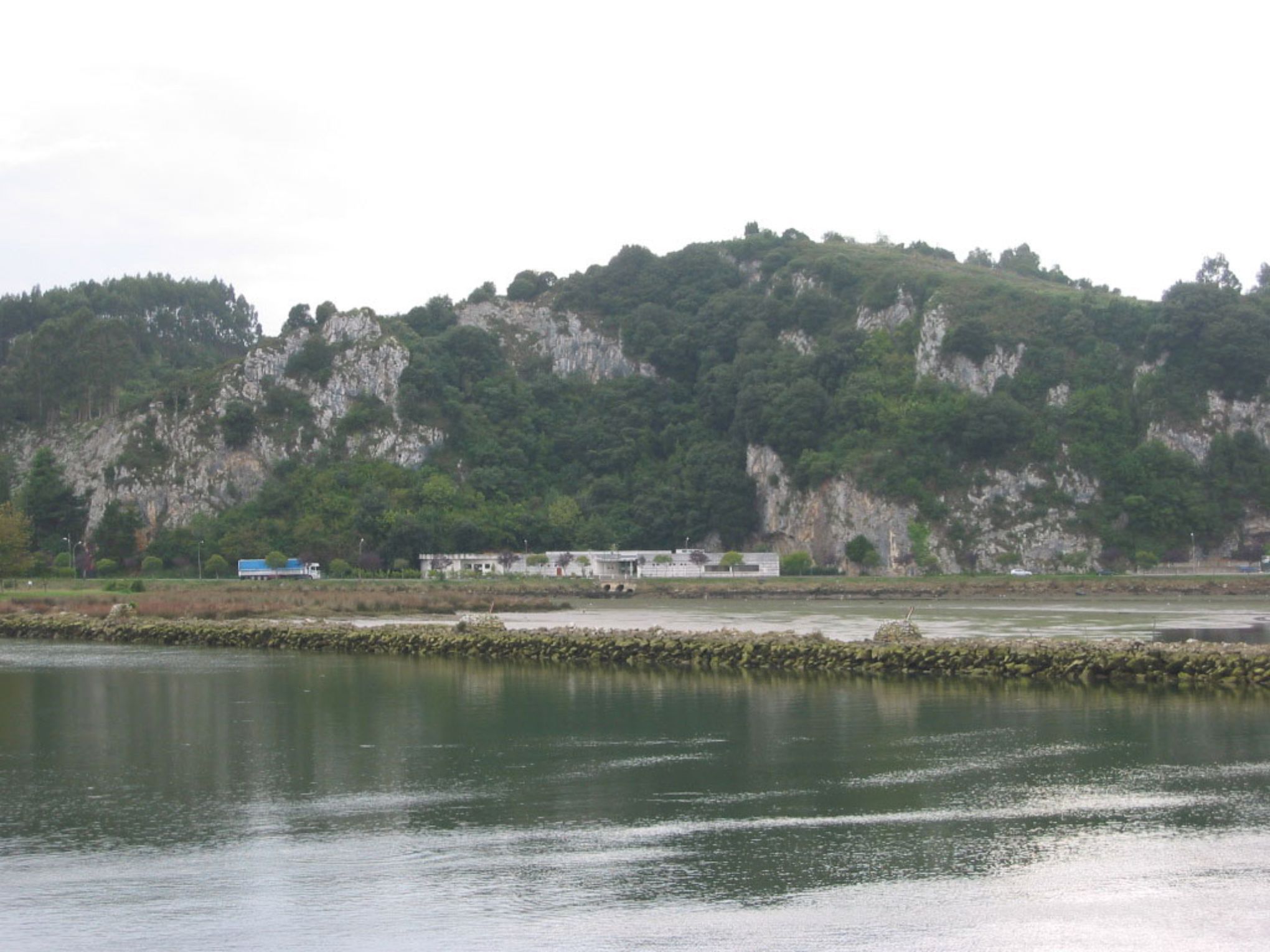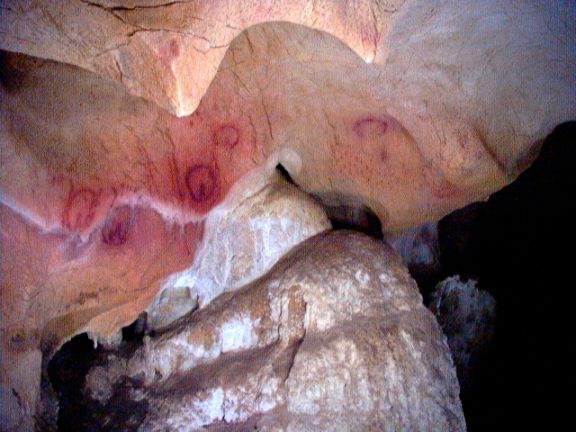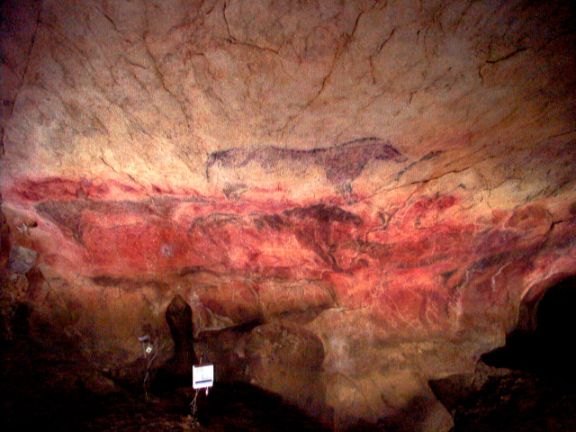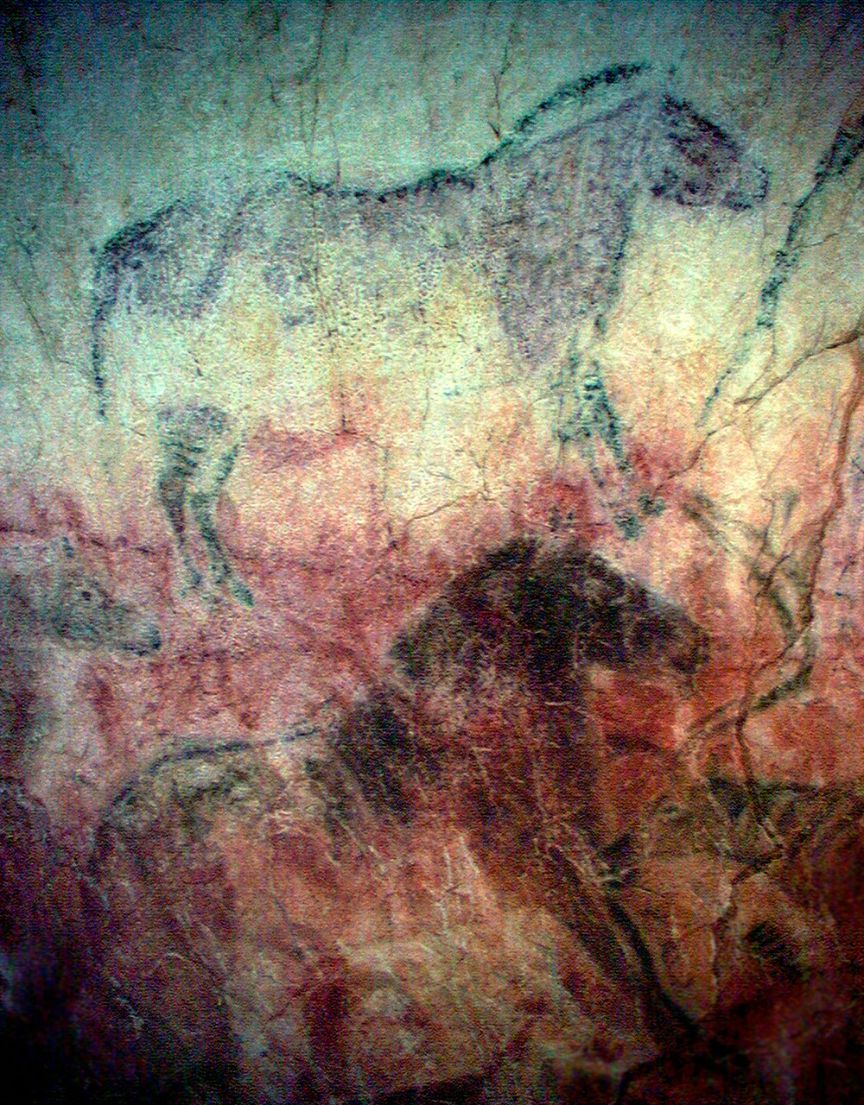Tito Bustillo Cave

Identification of the Property
SubirEl Pozu’l Ramu. El Pozu la Cerezal, Ardines, Ribadesella, Principality of Asturias
Access
From Ribadesella take the N-634 towards Gijón. After crossing the bridge over the River Sella, turn on to the RS-2 to the cave.
Geographical coordinates
UTM 30T 332525E / 4814300N Z: 15
Description
SubirTopographic description
The cave is situated in Ardines Hill, a small limestone hill on the left bank of the estuary that is the mouth of the River Sella. This hill is highly karstified, which explains, together with its excellent geographical situation, the profusion of archaeological sites inside its caves.
A large passage 750m long runs east-west, with numerous side-passages and chambers, a result of the connection of two caves, having entrances from La Cuevona and the valley of the River San Miguel. It is connected to La Lloseta by a difficult shaft.
Date of Discovery
A group of cavers found the extraordinary cave art when they descended a shaft on Ardines Hill, called “Pozu'l Ramu”, in April 1968.
Archaeological Research
The archaeological deposit found near the western entrance of the cave was dug by M.A. García Guinea in 1970 and by A. Moure Romanillo in 1972-1975. These excavations, which are by no means exhaustive, determined the existence of a sequence of occupation in the Magdalenian period, with an abundant bone assemblage, portable art objects, and remains of the artistic work below the main decorated wall.
The art ensemble has been studied by numerous prehistorians, especially Moure Romanillo and R.de Balbín Behrmann. The systematisation of the art was achieved by Moure Romanillo in the course of several studies. In recent years, Balbín, together with J. Alcolea, has published the discoveries of new depictions, not all of which have scientific consensus. An extensive bibliography has been generated by these studies (see below).
Artistic contents: paintings and engravings
Tito Bustillo is one of the five most important Palaeolithic cave art sites in North Spain. The following description of its contents is taken from the studies of A. Moure Romanillo. This archaeologist has divided the cave into two sectors, corresponding to two hypothetical independent sanctuaries: western and eastern. The eleven groups of cave art are divided into these two sectors.
Western sector: Linked to the occupation of Tito Bustillo Cave.
- Zone XI. It corresponds to the habitat area near the original entrance. A large red bovine on a fallen block, the head of an auroch engraved on the outside, to which may be added some red lines, a claviform sign and a vulva.
- Zone IX. This corresponds to the junction between the passage leading to the principal decorated area and the main passage in the cave. It contains the large figure of a horse in violet, together with a rectangular sign and engravings of horses, a bovine and a reindeer.
- Zone X. Main wall with polychrome figures, and a complex stratigraphy of superimposed engravings and paintings. It includes seven horses and four reindeer over a background of red ochre which hides earlier depictions in red and black. On top of the polychromes there are numerous engravings drawn with multiple lines. Next to these there are further black figures of deer, bison, auroch and horse, as well as engravings that remain unstudied.
- Zone VIII. Known as “Gallery of the Horses” it is found in a difficult side-passage. It contains several groups of engraved figures, with an auroch, a deer and a bear as well as several horses.
 Pulse para ampliar
Pulse para ampliar
 Pulse para ampliar
Pulse para ampliar
Eastern sector: Possibly linked to the occupation at La Cuevona.
- Zone VII. In a side-passage, engravings of a stag, an ibex and a cetacean.
- Zone VI. Two walls opposite each other; on one side red vertical lines and on the other engraved signs and a hand in red.
- Zone V. Five groups of figures with red stains, lines, a hand, a bison painted with red wash, and a posible vulva.
- Zone IV. Four groups with simple incisions, red dots, loop-shaped signs, claviforms and a grille.
- Zone III. Known as “Chamber of the Vulvae”, it contains several red images of female sexual content, together with two stylisations of female torsos.
- Zone II. Four groups of linear signs, red dots and an engraved circle. In one case, a bison is depicted using the natural shape of the rock and has red dots inside its body.
- Zone I. Three painted and engraved groups with deer, an auroch, dots, diverse signs, and a horse, an Ibex and a further two aurochs.
Various proposals have been made for the chronology of the different groups. The eastern groups and Zone
- VII have been assigned to the early-middle Magdalenian and Zone VIII to the late Magdalenian. The large panel contains figures produced throughout the Magdalenian (Moure and Balbín). However, other researchers (Fortea) have intuited a long sequence, like that seen at Llonín Cave, with artistic activity from the Gravettian to the late Magdalenian.
 Pulse para ampliar
Pulse para ampliar
Bibliography
SubirBALBÍN BEHRMANN, R. DE, MOURE ROMANILLO, J. A. 1980. Pinturas y grabados de la cueva de Tito Bustillo (Asturias): Elconjunto I. Trabajos de Prehistoria 37: 365-382.
BALBÍN BEHRMANN, R. DE, MOURE ROMANILLO, J. A. 1981. Pinturas y grabados de la cueva de Tito Bustillo (Asturias): conjuntos II al VII. Boletín del Seminario de Estudios de Arte y Arqueología, XLVII: 5-43.
BALBÍN BEHRMANN, R. DE, MOURE ROMANILLO, J. A. 1983. El panel principal de la cueva de Tito Bustillo (Ribadesella, Asturias). Ars Praehistorica I: 47-96.
BALBÍN BEHRMANN, R. DE, 1989. L’art de la grotte de Tito Bustillo (Ribadesella, Espagne): une vision de synthèse. L’Anthropologie 93-2: 435-462.
BALBÍN BEHRMANN, R. DE, ALCOLEA GONZÁLEZ, J. J., GONZÁLEZ PEREDA, M. A. 2003. El macizo de Ardines, Ribadesella, España. Un lugar mayor del arte paleolítico europeo. El arte prehistórico desde los inicios del siglo. Primer Symposium Internacional de Arte prehistórico de Ribadesella: 91-152. Ayto. de Ribadesella.
BALBÍN BEHRMANN, R. DE, ALCOLEA GONZÁLEZ, J. J., GONZÁLEZ PEREDA, M. A. 2009. Documentación arqueológica en la cueva de Tito Bustillo (Ardines, Ribadesella): campañas de 2003 a 2007. Excavaciones Arqueológicas en Asturias 2003-2006. 411-420. Oviedo.
BELTRÁN, A., BERENGUER, M. 1969. L’art pariétal de la grotte de Tito Bustillo (Asturias). L’Anthropologie 73: 579- 586.
GARCÍA GUINEA, M. A. 1975. Primeros sondeos estratigráficos en la cueva de Tito Bustillo (Ribadesella, Asturias). Excavación de 1970. Santander: Patronato de las Cuevas prehistóricas de la Provincia de Santander.
JORDÁ, F., MALLO, M., PÉREZ, M. 1970. Les grottes du Pozo del Ramu et de La Lloseta et ses réprésentations rupestres paléolithiques. Bulletin de la Société Préhistorique de l’Ariège XXV.
MOURE ROMANILLO, J. A. 1975a. Excavaciones en la cueva de Tito Bustillo (Asturias). Campañas 1972-1974. Oviedo. Instituto de Estudios Asturianos.
MOURE ROMANILLO, J. A. 1975b. Datación arqueológica de las pinturas de Tito Bustillo (Ardines, Ribadesella, Asturias). Trabajos de Prehistoria, 32.
MOURE ROMANILLO, J. A., CANO HERRERA, M. 1976. Excavaciones en la cueva de Tito Bustillo (Asturias). Trabajos de 1975. Oviedo. Instituto de Estudios Asturianos.
MOURE ROMANILLO, J. A., CANO HERRERA, M. 1979. Tito Bustillo Cave (Asturias, Spain) and the Magdalenian of Cantabria. World Archaeology 10-3: 180-189.
MOURE ROMANILLO, J. A. 1980. Las pinturas y grabados de la cueva de Tito Bustillo. Significación cronológica de las representaciones de animales. Studia Archaeologica 61. Valladolid.
MOURE ROMANILLO, J. A. 1989. La caverne de Tito Bustillo (Asturies-Espagne). Le gisement paléolithique. L’Anthropologie 93-2: 407-434.
MOURE ROMANILLO, J. A. 1992. La cueva de Tito Bustillo. El arte y los cazadores del Paleolítico. Gijón. Trea.
NAVARRO GASCÓN, J. V., GÓMEZ GONZÁLEZ, M. L. 2003. Resultados analíticos obtenidos en el estudio de pigmentos y posibles materiales colorantes de las pinturas de la cueva de Tito Bustillo. El arte prehistórico desde los inicios del siglo XXI. Primer Symposium Internacional de Arte prehistórico de Ribadesella: 161-172. Ayto. de Ribadesella.
POLLEDO GONZÁLEZ, M. 2011. El arte paleolítico de Tito Bustillo. Cazadores y artistas en la cueva del Pozu´l Ramu. Pola de Siero. Ménsula Ediciones.



